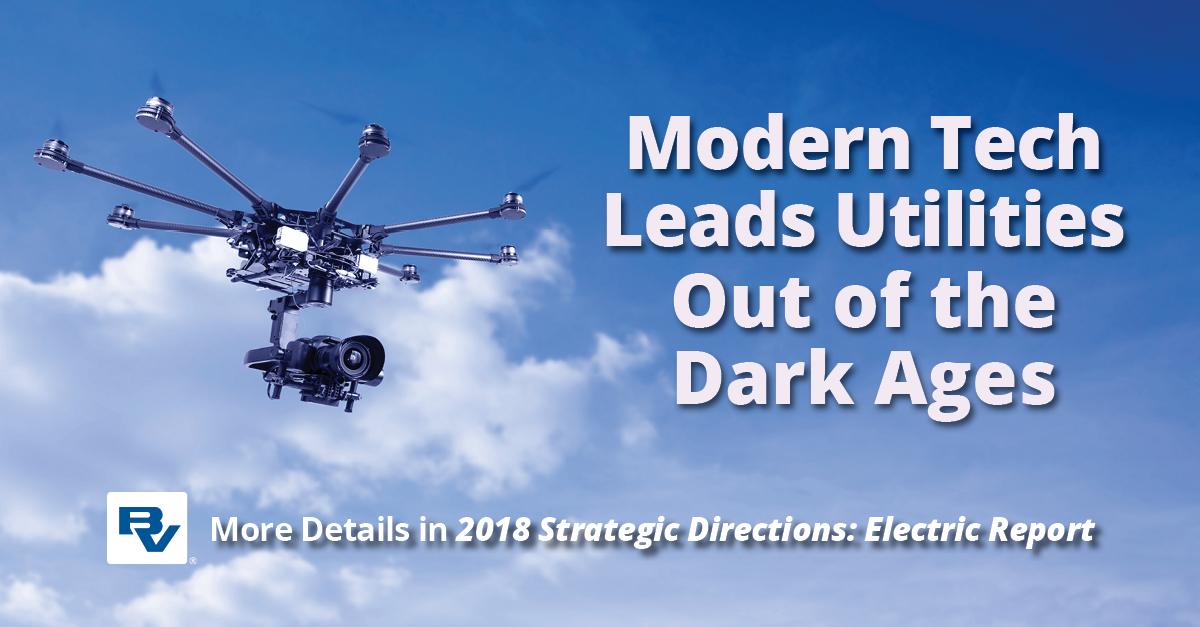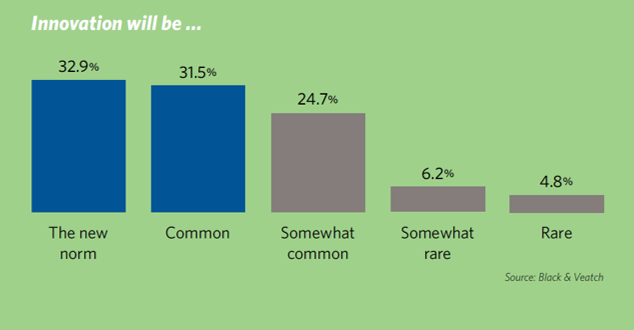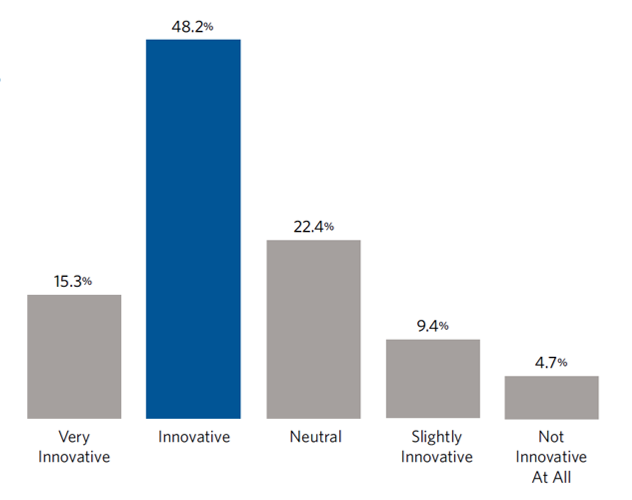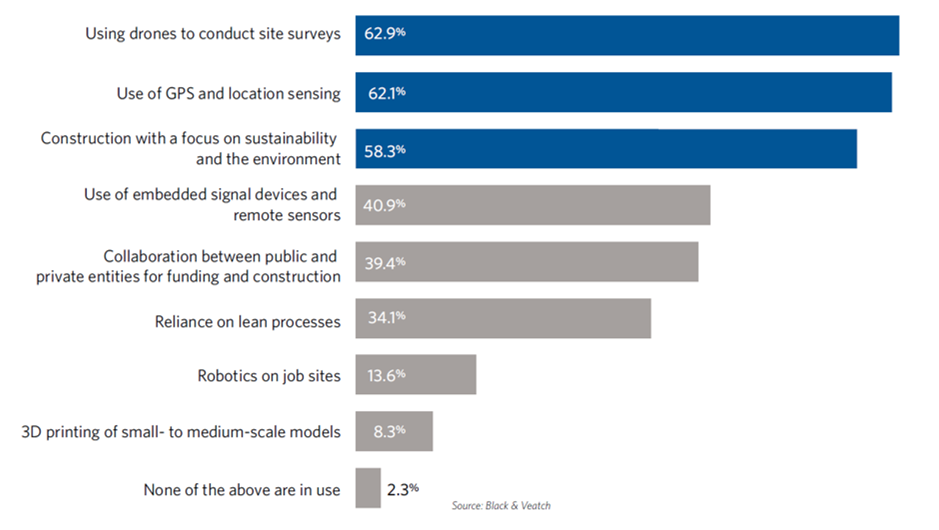From Drones to Sensors: Innovation Gaining Sway Among Electric Utility Leaders
Electric utilities are awakening to the power afforded by dynamic advances in technology
With their infrastructure graying and renewable energy posing growing threats to their customer bases and bottom lines, electric utilities are awakening to the power afforded by dynamic advances in construction, from the deployment of drones to innovative construction practices. Amid the prospect of a continued shift to decentralized, digital grids and the broadening appeal of increasingly affordable solar power systems, electricity suppliers no longer have the luxury of resisting change or delaying the adoption of next-generation power delivery.
Such a realization has become strikingly clear in the results from the Black & Veatch 2018 Strategic Directions: Electric Report survey, with one-third of respondents acknowledging that construction innovation over the next half decade will not only be expected, but become the new norm as utilities tactically work to fix or replace their aging infrastructure (Figure 1).
A similar percentage of respondents believe that acceptance of forward-thinking approaches will be common, further reflecting the allure and importance of innovations viewed as vital in addressing a customer base with an ever-widening buffet of power options. That heightened recognition comes as utilities ramp up investments in transmission and distribution networks while padding their mix of renewable energy and DER, eager to bolster reliability and resilience in an evolving power grid landscape.
Taken a bit further, nearly half of respondents reported separately that they consider their utility’s approach as innovative in building out infrastructure, while an additional 15 percent rated themselves a step higher at “very innovative” (Figure 2).
That’s no small finding in a sector long labeled as seldom creative or innovative: “Why would I modify this ball when it’s been round forever.” Complexities of and disruptions in the marketplace — everything from the surging popularity of DER to shifting expectations by consumers who now are savvier and demanding — may be pushing utilities to finally consider shucking the bindings of the status quo and, with regulators permitting, proactively make the investments necessary to smartly, and even courageously, modernize.
PORTLAND PROJECT ILLUSTRATES INNOVATIVE ENGINEERING
After more than a decade of planning as part of an $83 million project, Oregon’s Portland General Electric (PGE), the power provider to more than 800,000 regional customers, went about replacing an 80-year-old substation near the city’s downtown
and the Willamette River to ensure reliable power. By PGE’s estimation, the ambitious effort was crucial in supplying sustainable power to a downtown core it called “the nerve center of the region’s business and government and a hub for education, transportation and tourist attractions.”
The challenge was installing more than a mile of new 115 kilovolt (kV) cross-linked polyethylene cables — replacements to some undersea lines dating to the 1950s — that would link one of the utility’s substations to the new Marquam Substation, along the way spanning the new Tilikum Crossing Bridge, which is widely popular among buses, trains, pedestrians and cyclists.
Black & Veatch engineers and PGE ran the cables, each with temperature-sensing technology, under a dozen lanes of Interstate 5, hooking up with the Marquam site on a nub of land between two freeways and skirted by roads, homes and heavily-treed parkways. The buildout also involved raising a street and boring beneath Interstate 405 four 235-foot-long tunnels that would eventually house underground transmission lines to the new substation, supplying the PGE energy grid that serves Portland’s downtown.
DRONES PROVE VALUE AS INFRASTRUCTURE EYE IN THE SKY
For decades, since utility poles were first conceived, it’s been the lasting image: An electric company’s lineman meticulously scales the slender, rounded tower of wood to get a look at transmission lines and their hardware that only eagles could otherwise enjoy. With unmanned aerial vehicles (UAVs), known colloquially as drones, such labor-intensive, potentially perilous work is rapidly turning more obsolete as airborne application of the technology widens.
According to Black & Veatch’s survey, nearly two-thirds of respondents say their region deploys drones for site surveys, narrowly topping the use of global positioning systems (GPS) and other location-sensing means as innovations being harnessed in power infrastructure construction (Figure 3).
Although currently limited by federal airspace rules requiring drones to always be in the operator’s line of sight, utilities have turned to UAVs to inspect power lines and capture highdefinition images or video of the insulators and other key assets, sparing a worker from the livelihood’s underlying dangers of ascending a pole, boiler or smokestack or requiring the use of pricey helicopters or planes for such a peek.
The upshots are quicker responses, an enhanced safety record, increased frequency of inspections, real-time assessments of replacement needs and more data that can be analyzed for the clearest possible picture of risk management. FirstEnergy showed that UAVs offer an environmental bonus. The Ohio-based electric utility uses drones to inspect the nests of protected and highly territorial birds of prey, including ospreys and eagles, atop utility poles and other electric equipment. FirstEnergy and wildlife officials plan to team up later in 2018 to use the drone footage to identify and build new nesting platforms for the birds, far from electrical equipment.
On the construction front, drones have performed admirably with otherwise treacherous jobs such as providing wetland overviews and evaluating various stages of buildouts, offering visual verifications and validations that bolster a project’s cost efficiencies. Black & Veatch, a proven global industry leader in applying drone technology, has performed many successful visual line-ofsight
flights over dams, transmission lines, solar fields and streams as part of a stream-restoration project. (The company also was recently tapped to support the Kansas Department of Transportation in a Federal Aviation Administration pilot program that explores whether evolving rural drone applications merit easing federal restrictions of their use.)
Location-sensing devices such as GPS have also proven their resource-management worth for utilities as replacements for human surveyors, given that such things as transmission towers and wind turbines need to be installed in precise locations. Builders often lean on GPS to pinpoint use of their earth-moving equipment or backhoes. The accuracy and speed of location-sensing devices are at a premium, with the added benefit of more efficient operations of heavy machinery cutting emissions and stoking environmental stewardship.
Construction with an eye for sustainability and the environment remains among the top-of-mind challenges in the industry, with 58 percent of respondents saying their region has applied that approach. Other innovations remain relatively slow to come despite their acknowledged potential.
The Black & Veatch survey showed that just one-third of the respondents reported that their infrastructure buildout involved lean
construction, meant to stoke worker output and flow by employing such things as just-in-time delivery while ridding a project of any wasteful tasks. Such a method strives to optimize value for all of a project’s stakeholders by lowering costs, limiting delays, accelerating the completion time and emphasizing safety.
In the meantime, a sliver of survey respondents (8 percent) said they were making use of 3D printing of small- to medium-scale models. That marks a surprising lack of acceptance of a tool often viewed as beneficial in making project designs more vivid and for ensuring its viability, with users able to see how even subtle mockup changes can have a cascading effect on the overall design. These models can save money by averting costly changes or corrections in the actual construction.
In an industry being reshaped by the rise of renewables and burgeoning consumer choices, utilities must continue engaging customers to meet their demand for new technology and a lower carbon footprint, reinventing along the way their dynamic with regulators in a bureaucratic framework to produce impactful change. Black & Veatch can assist in that, having long helped clients assess their system needs, craft generation alternatives and help design modifications. Now more than ever, the rapidly changing energy landscape demands agility by utilities, and those that resist innovation do so at their own peril.





